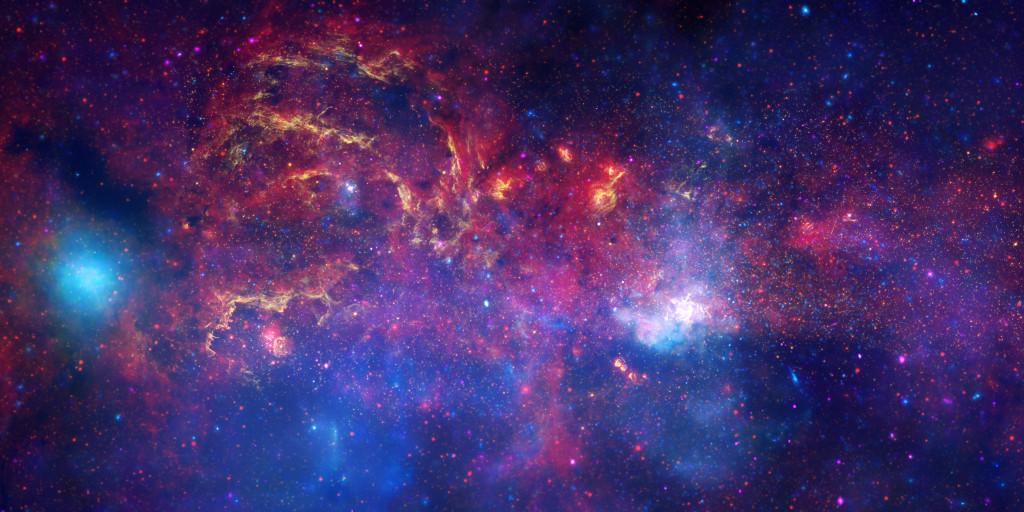Mapping Your Dark Matter
Posted by: Matt SalerI’m the kind of person who will immediately pick up any book of Hubble Space Telescope photos or read about galaxies in my spare time. I make Phil Plait’s Bad Astronomy blog a daily must-read and have a sky map app on my phone’s homescreen. I’ve currently got two different space photos set as my desktop background on two monitors.
I don’t claim any real level of expertise, but I’m fascinated by this stuff.
I mean, look at this mosaic of the Andromeda Galaxy:
If you look at a hi-res version, it looks pixelated, but it’s not. Those are stars. Mind-blowing, huh?
This post isn’t just an excuse to post some great space photos, though it’s at least partly that. Here’s another:
That’s our galactic center, including the region containing a supermassive black hole in the white area on the right.
But that’s just the stuff we can see.
Dark Matter
My amateur interest in space recently got me thinking about how something we can’t see, a concept in astrophysics called dark matter, might relate to my professional interest in content and the work we do with it for our clients.
I’ll let Neil DeGrasse Tyson explain what dark matter is:
The too-long-didn’t-watch version: it’s something we know must exist, but don’t know much of anything about. Yet.
Phil Plait goes into slightly more detail:
Dark matter was discovered a long time ago, when it was found that galaxies that live in clusters were moving way too fast to be held by the cluster gravity. They should just simply shoot away, and clusters would essentially evaporate. This implied that clusters of galaxies were either very young and hadn’t had time to dissolve — which we knew wasn’t true; they’re clearly old — or there must be a lot more gravity holding them together. We can add up all the light from the stars in the galaxies and estimate their total mass, but what you get is only about 5-10% of the mass needed to hold clusters together. So most of the matter making up the clusters must be dark. Otherwise we’d see it.
It’s also what gives galaxies their rotation speed—without it, galaxies would rotate slower.
Dark matter is an essential piece of the cosmos. The problem is that we can’t observe it directly, which makes learning more about it difficult. But we’re working on that.
Cosmologist Sean Carroll recently explained why it’s important to study dark matter, despite the fact that we can’t see it:
Only 5 percent of the universe, by mass, is the ordinary stuff out of which you and I are made. So, if you care about understanding the universe, 95 percent of it is dark matter and dark energy. If you want to know how the universe works, you have to understand that stuff. (my emphasis)
Carroll went on to say,
It’s very annoying to us, as scientists, because we know it’s there. We know how much of it is there. We know where it is. But we don’t know what it is. We don’t know what is actually making up the dark matter. So the more we can study its properties, how it collects, how it evolves over time, the more of a hope we get to understand what it is made out of and why there is dark matter at all.
Those comments from Carroll come from a news piece about a dark matter map scientists with the Dark Matter Survey released earlier this year (below).

The reason for making this map is that quest for knowledge about the universe Carroll talks about above. Maps like this help scientists make sense of what we see out there, whether it’s how galaxies form, move and evolve, or how they collect together in clumps. Maps like this helps scientists take dark matter into account.
What does this have to do with content?
At the start of many web projects, content is like dark matter. It’s something—text, data, graphics, video, audio—both agency and client know exists, but it’s not fully understood. We know it’s essential to the website, that it makes up the largest chunk of the site’s mass, that without it the site wouldn’t work or hold together very well.
Despite that, it’s easy to get caught up in what I’ll call the luminous material, the design and development. Those are the stars and galaxies of the web, the stuff that’s easy to see and conceptualize—and they’re essential pieces.
However, design and development without a full accounting of content is like cosmology in the days before the discovery of dark matter. At the time, scientists’ theories for galaxy rotation and clustering didn’t match up with observation. Model galaxies would fall apart, because dark matter wasn’t part of the equation. The models had to adapt for the presence of the stuff in order to work.
The same is true for websites: you need to understand your content if you want to keep your site from falling apart or spinning too slowly.
Fortunately, we can observe content directly. If we take the time, we can catalog it, organize it, adjust it, cull it, create it, plan for its future, and more. In other words, we can build a dark matter map. We call this map content strategy.
Content strategy is an essential component to any successful website project. A good content strategy will tell you what you have, why you have it, what you need, and where you’re going with it. It will align with and inform your goals, making them achievable from where you are now. It will turn your dark matter into a fully-known piece of the puzzle.
We’re interested in helping you discover what makes up your dark matter. Together, we’ll plot out how it collects and evolves. And we’ll help you plan for its future.
What can we map for you?

